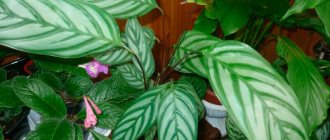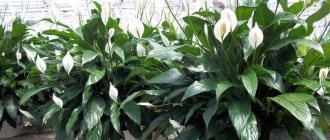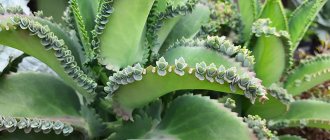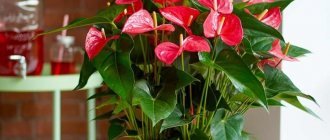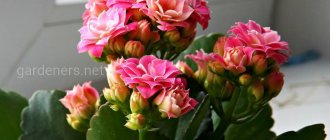Calathea is part of the arrowroot family, which occupies one of the first places among variegated crops. The origin of arrowroot is associated with the tropical rainforests of Central and South America, which determined their relationship to light and air humidity. The distribution area of calathea species is quite extensive and occupies significant areas in the tropical zone of all continents. The exception is Australia, which is separated from the rest of the continents by a significant expanse of water. Marantaceae are also widespread in Africa, where they are represented mainly by endemic species. Some species are found in India, Burma, the islands of the Malay Archipelago and Oceania.
Saffron Calathea (Calathea crocata). © Stefano
Biological features of the arrowroot family
Representatives of the family to which Calathea belongs are mainly herbaceous and liana-like perennial plants. The rhizome is the main storage organ in which reserves of water and nutrients accumulate. They need constant high humidity. In dry climates, they quickly evaporate water and die.
Maranthaceae belong to decorative deciduous plants. Their main charm is their large variegated leaves, which have a remarkable property characteristic only of this family. At the end of the petiole, closer to the leaf blade, there is a thickening that lifts and turns it towards the light source in order to capture the remnants of rays penetrating under the canopy of a moist forest. For this feature, calathea is called the “prayer flower.” In the morning, the leaves are horizontal, and in the evening they fold and rise almost vertically upward, like palms in prayer.
And one more feature distinguishes arrowroot from other plants growing in the same zones. In some species, after flowering, the entire aboveground part dies off. But the plant does not die and does not retire. After some time, with continued watering, young shoots appear and the plant comes to life. Of the 30 genera of the family, 4 are grown indoors, including calathea.
Types of calathea with names and photos
Dozens of varieties of prayer flower are used for growing at home. This article provides descriptions of the most common and unusual of them. A complete catalog of the most popular varieties, called “Calathea Mix,” would take several pages.
Decorated
Calathea ornata reaches a height of about 80 cm with a leaf size of up to 25 cm. It is a brightly decorated plant. The oval plates, slightly pointed at the tips, seem to be painted with oblique white lines. It is curious that the paired lines of a young flower have a pinkish tint, and over time they turn white.
The stripes run between the lateral veins of the calathea leaf, and the light green central vein of the ornata leaves also stands out clearly against the dark green background. And these are not all the colors of the Calathea plant: the lower part of its leaf blade has a reddish tint, and the inflorescence spikelet is topped with purple or white small buds.
Wonderful
Calathea insignis is a plant up to 1 m high with sword-shaped dense leaves reaching 45 cm in length and 8 cm in width. Their main feature is the presence of oval dark green spots on a light background, located as if they were small leaves growing from a central vein. In addition, each large leaf of the flower has a dark green, slightly wavy edge.
The back part of the leaf of the calathea plant has a wonderful purple tint, which during traditional evening “prayer” creates an effective contrast with the calm colors of the front side.
Calathea Makoya
Calathea macoyana is a species that is popularly called the peacock flower. Wide oval leaves reach 20 cm in length with a total plant height of 60 cm. The main color of the plates is light green. When you look at the leaves of Calathea Makoya, you get the feeling that the artist painted dark green small leaves and dashes of varying widths on them.
The oval leaves of this plant species are transparent to light and somewhat resemble parchment. The lower part is “lined” with burgundy lines.
Calathea Lubbersa
A peculiarity of the indoor plant Calathea lubbersiana is that the back side of its leaves is painted in a single green color, and on the front there are yellow, white and green spots (depending on the variety), located in a chaotic order.
The wide, oval-shaped leaf reaches 30 cm in length. The height of the entire plant, with proper care, can reach one and a half meters.
Calathea crocata
This plant is known to many as saffron calathea. Attracts with bright orange buds on purple peduncles, as well as a compact crown of corrugated oval leaves with wavy edges.
The front surface of the glossy plates, reaching a length of 30 cm, is painted emerald green with whitish stripes, and the back surface is coffee or reddish. The total height of the bush is no more than 45 cm.
Other varieties of calathea
It is impossible to list all the types and varieties of prayer flowers. Let’s highlight a few more that have gained the most popularity among indoor plant lovers.
Calathea roseopicta
It reaches a height of 50-80 cm. It is represented by a large number of varieties, the main feature of which is the variegated color of the leaves. Large oval plates with their pattern consisting of bright stripes and spots of different colors resemble the plumage of birds of paradise. The color scheme of the elements decorating the front part of the sheet varies from dark green to deep red. The back side of the leaves is bordered with a pink-purple edging, which explains the name of the plant. Some varieties change color as they mature.
For example, the leaves of young roseopicta sylvia have faint pink stripes, and when the plant reaches maturity, it turns silvery green. In this case, the underside of the plates remains burgundy.
Inflorescences, depending on the variety, can be white, purple or bright yellow.
Calathea dotty
The most unusual variety of roseopicta. This compact bush, whose height and diameter ranges from 15 to 30 cm, attracts attention with its original colors of almost round leaf plates with a pointed tip and wavy edge. The outer side of the leaf is dark green with a malachite tint. A wide lilac-pink vein runs through its center. About one and a half centimeters from the edge of the plate there is a narrow edging of the same color. The color of the back side of the leaf is purple.
A five-petalled light green peduncle extends from the center of the rosette. Small and inconspicuous purple or white spike-shaped inflorescences bloom on it for a short time.
This plant is often confused with Roseopicta illustris. They have many similarities, but the leaves of dotti are somewhat lighter and 2-3 times smaller.
Calathea sanderiana
A variety bred from Calathea ornata (decorated). In indoor conditions it reaches a height of 70 cm. It is characterized by relatively small but rather wide egg-shaped leaves (their maximum length and width are 20 and 13 cm, respectively). The upper part of the dark green plate is streaked with clear lines of white, beige, silver or red, extending from the middle of the sheet to its edges. The underside is most often purple or light burgundy.
Calathea varshevich
If you are interested in a variety of prayer flower, the leaves of which are “painted” only with shades of green, you should pay attention to Calathea Warszewicz, which, moreover, can please you with white flowers. The Misto variety is very similar to this plant.
A completely opposite characteristic can be given to the Triostar variety, which has “part of the face on the wrong side” and vice versa. That is, unlike other types of calathea, where the back side is often painted in warm colors, and the front side in different shades of green, the leaf blades of this culture may partially have fragments of burgundy, pink, green, etc. regardless of the side.
Calathea network
A relatively new variety of prayer flower. This low, spreading plant bears little resemblance to its other relatives. Large dense heart-shaped leaves seem to be assembled from the smallest fragments of an irregularly shaped mosaic, representing light or shaded rectangles.
In addition to the unusual color of the leaves, mosaic calathea differs from other species in that it is less demanding in terms of maintenance conditions.
Calathea litze
The plant reaches a height of up to 60 cm. Its pointed leaves have the shape of an elongated ellipse with a length of 8 cm and a width of 6 cm. They are distinguished by uneven edges. The front surface of the leaves has a glossy surface. The pattern consists of alternating strokes of dark green and light green color, extending from the central vein in a checkerboard pattern. That is, opposite a light stroke is a dark one and vice versa.
The back side of the plate is painted lilac or violet. Small white inflorescences of Calathea litze are of no decorative value.
Calathea freddy
Those wishing to acquire a more compact variety with a similar pattern should pay attention to the Freddy variety.
Calathea bachema in its appearance also resembles Freddie, but has longer light green (almost white) lanceolate leaves, on which, in addition to green pointed “layers” from the central vein, thin, barely noticeable stripes are also drawn.
Calathea striped
It is characterized by the richness and richness of the colors of large and wide leaves. The pattern on the plates of regularly alternating stripes is associated with the color of the zebra, calling the flower zebra (although this is a purely arbitrary name, and there is a botanical species of Zebrina among the Tradescantia). It is created from different shades of green. The lower part of the leaf is purple.
The flowers are lilac or white, very similar to small roses. Supporters of more restrained shades should pay attention to the “Beauty Star” variety of Calathea. The dark green leaves of this plant are painted with light green and white strokes in such a way that the border and the space near the central vein remain untouched. Both varieties can reach 75 cm in height.
Calathea pinstripe is very similar to Beauty Star, but there are differences. This species is taller (can reach a meter in height). Its leaves are slightly darker and pointed.
Calathea vicha (veicha)
Reaches approximately 90 cm. On its large dense oval leaves, an original pattern is created from internal green and lateral yellowish stripes. The reverse side is painted in a single color purple.
This variety of calathea has noticeably rounder leaves than most other species. The advantages include the figured edge of the sheet and its attractive pattern.
Calathea orbifolia
One of the few types of prayer flower whose leaves grow on low petioles is Calathea orbifolia. Large circular plates, unlike the Wicha variety, have a more elegant color, representing an alternation of light green and silver-green stripes.
Thanks to their shape and strict geometric pattern, the leaves of the calathea are somewhat similar to the carved monstera leaf. Fasciata has almost the same regular, but wider stripes. The lanceolate leaves of Rufibarba also grow on long petioles.
Beautiful Calathea
Calathea is a perennial plant with a storage root system in the form of a tuber or rhizome. Indoors it grows up to 1.0 m or more. A lush cap of variegated leaves is formed on shortened internodes, where leaves of various shapes are located on long petioles - from lanceolate to oval-rounded with a smooth or wavy edge.
The leaves are large, up to 10-20 cm in length. The undersides of the leaves are usually purple-pink in color. Sometimes they are completely dark green. The upper side of the leaf blade is spotted, divided into separate segments by white lines. The midrib of the leaf is thick and was previously used as a basket weaving material. Hence the name calathea, which means “basket” in Greek.
Every year, calathea forms 5-6 young leaves. Different types of calathea bloom from early spring to summer. The inflorescence in the form of a compact spike bears small, inconspicuous flowers of different colors - from white to dark purple. Flowering can last up to 3 weeks. But, it should be noted that among the species of this genus there are also beautifully flowering ones (Calathea Makoya, Calathea saffron, Calathea Varshevich).
Calathea bachemiana. © Maja Dumat
Pests on Calathea
If we talk about the indoor calathea flower, pests in the form of parasites are most often encountered due to various problems in caring for and growing the plant:
- Spider mite. Symptoms of the parasite include a white coating on the underside of the leaves. Over time, cobwebs become noticeable on the plant. The tick is very small and difficult to see. The leaves first turn yellow and then begin to fall off. The pest prefers dry air, so the flower must be sprayed frequently. In addition, mechanical treatment with an insecticidal agent is carried out.
- Shield. When infected, small round plaques appear on the stem and leaves. Over time, the leaves turn pale and dry out. The plant can be cured by treating it with a solution of laundry soap. To consolidate the results, it is necessary to spray with Fitoverm.
- Thrips. Small dots appear on the leaf plate, which gradually turn into spots. Small oblong-shaped insects that move in jumps are noticeable on the soil. If parasites are detected, it is necessary to rinse the plant in the shower and spray it with Intavir. To consolidate the result, you can repeat the spraying twice. The soil in which the flower is located is treated with the same solution.
Signs of plant damage by aphids
If pests are detected early, it is not difficult to combat them, since there are many insecticidal and folk remedies.
Calathea (home care, diseases, treatment are described above) is an attractive shrub that is often used as a decorative ornament. When the leaves of a calathea flower curl, what every gardener should know to do. The plant requires increased attention, and it must be grown taking into account all the rules.
Features of caring for calathea at home
Temperature and placement
Calatheas do not require high air temperatures. In summer, the optimal temperature is +16.. +24 ºС, in winter with non-irrigation +12.. +16 ºС. There are no drafts or bright light under the forest canopy, so calatheas are very sensitive to frequent temperature changes (when doors and windows are opened) and the flow of sunlight. In this regard, it is better to place them away from bright windows, from constantly slamming doors and drafts from open windows.
Excessive lighting “eats” the variegated foliage of the calathea. Trying to get away from bright light, plants roll up their leaf blades. In historically 4-cornered rooms, they will feel at home in a semi-shaded corner, while brightening up the dullness of a boring interior consisting of corners and furniture. Soft greenery, color (as if from the sun) highlights will enliven the interior of the room and add a new lively note to its decor
Soil for growing calathea
In their natural environment, calatheas grow on light, breathable forest soils. Therefore, in indoor culture they need the same substrate. For planting, prepare a soil mixture of leaf soil, peat and sand (2:1:1), with the addition of crushed charcoal, pieces of bark, and a small amount of coniferous soil. To improve physical properties and increase nutritional value, 20-30% humus is added to the mixture. In stores you can buy ready-made soil mixture for indoor flowers.
Humidity when growing calathea
The main condition for the normal development of plants is air humidity. It should be high enough all year round. Be sure to spray the plants daily with a fine-mesh sprayer with clean water (without calcium and chlorine). The calathea pot should be placed on damp pebbles or moss (without obvious water). As the water evaporates, the material in the pan must be moistened.
Species with velvety or hairy leaves should not be sprayed. It is better to bathe them in the shower 2 times a month and spray the air around the plants 1-2 times a day, creating a humid microclimate. Dust on the leaves is removed with a dry cloth or brush, since the surface of the leaves is very delicate and easily vulnerable. To increase the natural humidity in the room, it is better to grow calatheas together with other flowers in recreation areas, winter gardens, etc.
Moisture availability of calathea
In summer, calatheas are watered 2-3 times a week, and in winter once every 6-8 days. The next watering is carried out when the top layer (2-4 cm) of the soil dries out. Stagnation of water in the pan is unacceptable. Watering is carried out with a watering can with a narrow spout along the edge of the flower pot so that drops of water along with pieces of soil do not fall on the leaves of the plants.
Feeding for calathea
To provide a large above-ground mass with sufficient nutrition, calatheas must be systematically fed. During the growing season, they are fed 2-3 times a month with flower fertilizers without nitrogen and calcium. Fertilizing is carried out before and after flowering.
Calathea makoyana
Transfer
Calathea bushes grow rapidly. Young plants are replanted annually, adults - once every 2-3 years. Calathea tolerates this procedure most easily in early spring, early March.
Selecting a suitable pot and soil
The soil for calathea should be moisture-absorbing, loose and slightly acidic. The optimal mixture would be leaf soil, peat and sand (4:2:1). Be sure to add components that retain moisture - perlite, vermiculite or hydrogel - in the amount of 15-20% of the total volume.
For acidification, use a small amount of coniferous soil or sphagnum moss. Some gardeners recommend mixing a small amount of charcoal into the substrate to prevent root rot. You can purchase ready-made soil for decorative foliage plants. Pots are chosen wide and low.
Transplantation process
Calathea transplantation is carried out according to the following algorithm:
- The plant is removed from the old container along with a lump of earth, being careful not to damage the roots.
- If necessary, carefully separate the daughter sockets.
- A good layer of drainage and some fresh soil are placed in the new pot.
- Place the bush vertically so that it does not have to be buried.
- Sprinkle the substrate on the sides without compacting it and water it generously.
In order for the calathea to recover faster from the stress it has suffered, it is placed in greenhouse conditions for several weeks.
Transplantation and propagation of calathea
Young Calathea plants are replanted annually in February-March. The roots are painful to transplant, so the calathea is simply transferred to a new container without disturbing the lump of earth on the roots of the plant. For transshipment, wide, shallow pots are used, which is due to the superficial root system of plants. When planting, the rhizome is placed strictly vertically in the center of the pot and a new substrate is added around it. The soil in the pot is only slightly compacted around the planted plant.
This planting is necessary to maintain soil breathability. Otherwise, in a dense substrate, the roots of the calathea will suffocate and the plant will die. Adult plants are transferred to a new container less often, once every 2-4 years. The approximate time of replanting is determined by the appearance of roots from the drainage hole of the pot. When replanting, it is necessary to install a drainage layer of shards and large pebbles at the bottom of the pot.
Simultaneously with transplantation, the resulting shoots with 2-3 roots and several leaves are separated from adult plants. Young plants are planted in a prepared container and greenhouse conditions are created by covering the new planting with glass containers or a plastic bag to maintain high humidity and constant temperature. In the simulated greenhouse, the temperature fluctuates between +23.. +24 ºС.
The second method of vegetative propagation is dividing the rhizome into 2 parts. The sections are sprinkled with activated carbon. The remaining steps are the same as for transplantation.
How does calathea reproduce?
Calathea can be propagated in home floriculture in two ways - division and cuttings. The seed method is very labor-intensive and is not always possible even for professionals.
- The division method involves detaching several fragments with roots and leaves from the adult culture by hand. For speedy rooting, the lower part should be sprinkled with “Kornevin”. The sprouts should be planted in separate pots with a diameter of 7-9 cm and placed in a place where direct sunlight does not reach. Young plants will require regular watering, spraying and fertilizing.
- When cutting from a bush, it is necessary to separate the shoot using a knife, then plant it in watered soil, create a greenhouse using cellophane or a cut part of a plastic bottle. After new leaves appear, the prayer flower can be grown as an adult plant.
The methods described for propagating calathea are the most common. However, in the absence of full-fledged shoots, the prayer flower can also be propagated by leaves. In this case, the plate should be cut off along with the petiole and kept in water until roots appear on it. The further algorithm of actions is the same as for propagation by cuttings.
Protecting calathea from diseases and pests
The tender leaves of calathea are a tasty morsel for gnawing and sucking pests that try to settle on young leaves. If thrips, spider mites, scale insects, aphids, and whiteflies are found on other plants in the room, you must immediately take measures to protect Calathea from uninvited guests. In enclosed spaces (apartment, office, childcare center and other institutions) chemical agents should not be used to control pests.
- A regular soap solution (without adding alcohol) will help you deal with enemies. The solution is prepared from a mixture of 20 g of liquid or green soap and 1 liter of water. The mixture is thoroughly stirred until foam forms and the plant is treated. The soil is covered with a film to prevent soap solution from entering.
- You can pollinate plants with sulfur.
- Treat with a working solution of biological preparations, in accordance with the recommendations on the packaging: fitoverm, bitoxybacillin, Iskra Bio, etc. The preparations are practically harmless to humans and do not cause allergic reactions.
- Florists recommend using infusions and decoctions of onion peels, garlic, nut leaves and other natural insecticidal herbs. When using plant decoctions, be careful. It is better not to use infusions of poisonous plants (bitter pepper, Dalmatian chamomile, celandine, etc.) in the apartment; they are contraindicated for use in enclosed spaces.
Preparing the infusion. Finely chop 200-300 g of husks, cloves of garlic or nut leaves, add 1 liter of water and leave for 1 week. The result is a mother solution. From it we prepare a working solution in the proportion of 1 part mother solution to 50 parts water. Spray the plants with the solution through a fine spray bottle.
It should be noted that Calatheas, with proper care, practically do not get sick, but they are capricious and especially do not tolerate deviations from the norm when watering and air humidity, responding to disturbances of the root system (rot) and yellowing and falling leaves (loss of decorativeness).
Calathea: leaves dry around the edges, what to do
Caring for ampelous geranium or ivy-leaved pelargonium: diseases and pests
Why calathea leaves begin to curl and dry depends on several factors. Among the main reasons are poor watering and low air humidity. It is necessary to increase the volume of watering liquid and periodically spray the flower.
If these measures do not help improve the condition of the plant, it is necessary to cut off the leaves that have begun to dry out and try to save the root system. Place the pot on moistened expanded clay and cover with a bag. When new shoots appear, the bag can be removed.
To prevent dry leaf tips, you need to monitor the air humidity.
Before answering the question of what to do if calathea leaves curl, it is necessary to establish the cause of the pathology. In most cases, the answer lies in the lack of humidity in the air around the flower. Ideally, the humidity percentage should be at least 90%. Maintaining this mode is not easy, so it is recommended to purchase a humidifier.
If it is not possible to buy such a device, you need to spray the leaves daily with filtered and settled water. You cannot use regular tap liquid, as it leaves lime stains on the leaves, which are extremely difficult to remove in the future. This rule especially applies to calathea with velvety leaves.
If a leaf begins to dry out or curl into a tube, it must be promptly removed from the plant. Lighting should be diffused and soft.
Important! Exposure to direct sunlight can have various consequences. In addition to burns, leaves often dry out, lose color, and fall off.
If the tips of the leaves of a calathea flower dry out, you need to change the location of the flower. This move seems quite reasonable and often helps to save shoots.
Leaves can curl not only due to improper care or disease. The peculiarity of calathea is that all representatives of this species curl their leaf blades at night. This is a normal phenomenon that should pass during the day.
Calathea is a very elegant flower that will fit into any interior.
Spots on calathea leaves, curling and drying of the trunk can occur due to many reasons. Before treating a plant, it is necessary to accurately determine the source of the problem, otherwise there will be no positive result.
Growing calathea indoors
Considering the capricious nature of arrowroot, we can recommend several species of beautifully flowering and decorative foliage representatives of the Calathea genus for growing indoors. Easier than others to adapt to life in indoor conditions are Calathea Bachema, decorated, Makoya, striped, Veitcha. If you are patient, then Calathea saffron and Calathea Varshevich will bloom in the room, distinguished by bright bracts of different shades of white, pink, orange, mistaken for a flower.
Calathea Makoya. © Maja Dumat
Calathea Makoya
The tropical rainforests of Brazil are the natural habitat of Calathea Macoya. She does not like spraying and therefore will grow and develop better in greenhouses, where the natural air humidity is always quite high.
Under artificial lighting, this species is in no hurry to lose leaf variegation. It is distinguished by the amazing beauty of large (up to 20x10 cm) leaf blades on straight petioles up to 14 cm long. On an oval leaf blade of light green color with a dark green edge, with a thin brush of a natural artist, a second dark green, imparipinnate leaf is “painted” on top. The reverse side repeats the design, but in burgundy colors.
The unusual bright color of the plant is especially evident in the evenings, when the leaf blades rise up and curl, revealing the unique color of the underside of the leaf.
Calathea warscewiczii. © Blechdose
Kalathea Varshevich
A large species that forms the habit of a bush with dense rosettes of leaves from 0.3 to 1.0 m. The leaf blades are elongated-oval, slightly wavy. The leaf surface is dark green velvety with a light green herringbone pattern. The underside of the leaf blades is dark purple in color.
In addition to the leaves, the inflorescences of Calathea Varshevich are attractive in the form of spikelets on short burgundy peduncles. The few-flowered spikelet bears large light bracts (white, light cream) surrounding cream or pink flowers. Flowering begins in late spring and lasts up to 3 weeks.
Calathea saffron. © martinsvaxte
Calathea saffron (crocata)
This beauty from the banks of the Amazon attracts the eye with the special decorativeness of its “false” flowers, collected in short corymbose inflorescences on high peduncles.
The true flowers are small and inconspicuous, reddish or pink, hidden in large bracts of bright orange or saffron hues, mistaken for the flower. Against the background of 20-30 cm of velvety dark green leaves, bright orange inflorescences give the plant a special charm. However, for the onset of flowering, Calathea saffron needs a shortened daylight hours (8-10 hours a day), so flowering occurs in early spring or in the autumn-winter period.
Features of Calathea
Calathea is one of the most numerous representatives of the Marantaceae family. Under natural conditions, this plant can be found in the tropical forests of South America, India and Oceania, where it hides from the scorching sun in the shade of huge trees. Botanists know about 130 species of calathea, which differ in the shape and size of the leaves, as well as their unusual patterns.
The second name of the described plant is “prayer flower”. Calathea received it due to the unusual behavior of the leaves throughout the day. At dawn they are lowered, and in the evening they gradually rise, as a result of which the underside of the plates is exposed. Someone very attentive in England saw in this spectacle a man praying. Yes, that’s what he called it – prayerplant, which can be translated as a prayer plant.
Plants of the Calathea family are perennials. Representatives of a number of varieties can reach a height of 80-100 cm, and sometimes more. The prayer flower comes in many varieties, the leaves of which can be colored in different shades of green interspersed, striped or streaked with silver, white, purple, burgundy, beige and other colors. The back side of the plate is reddish, lilac or violet.
The crop blooms in the spring, producing a spikelet of white, pink or juicy orange color. In most species they are inconspicuous, but there are some representatives among the variety of calathea with attractive inflorescences.
Successfully growing beautiful indoor Calathea plants is not easy. This is a very finicky flower, which is unlikely to suit novice gardeners.
Reproduction
Arrowroot tricolor is propagated by vegetative methods:
- Dividing the bush. In this case, the mother plant is divided into several parts, each of which has developed roots and several leaves. The “divisions” are placed in separate pots with loose nutrient soil mixture, covered with mini-greenhouses made of film or plastic bottles. The best environment for their rooting is a warm room and sufficient moisture.
By cuttings. Trimmed ten-centimeter shoots, which have at least 3 leaves, are kept for half an hour in the Stimulin solution. Then they are dipped in a glass of settled warm water.
After a month and a half, when the roots sprout on them, the cuttings are planted in a sand-peat mixture and watered abundantly.Mini-greenhouses are also used with this method.
- On aerial roots. This method is used to reproduce adult plants. At the same time, aerial roots appear on the petioles of drying leaves; during the summer-autumn period they grow up to 15 cm long. By spring, buds appear at their ends, from which leaves then bloom. If you cut off such a rosette with a pair of leaves and part of an aerial root, you can replant it in a loose soil mixture or in water. Next, the process of growing a new plant occurs in a similar way to the methods described above.
- Growing from seeds is also possible. This is a more labor-intensive and time-consuming process, so it is used very rarely.
Container, soil, fertilizing
The selection of containers should take into account the structure of the calathea root system. The roots of the plant are superficial and grow in breadth. Therefore, you need to choose a flower pot that is wide, but not deep. Good drainage is required, otherwise moisture will accumulate at the bottom and cause rotting of the roots. Create a large drainage layer at the bottom of the container.
Soil for calathea should be purchased at a special store. Suitable soil for Saintpaulia with added sand or for azaleas, but without lime. To prepare the substrate yourself, you will need leaf humus, peat and sand. The ingredients are taken in a 2:1:1 ratio, respectively. Calatheas love slightly acidic soil (acidity pH 6).
We recommend: Is it possible to regularly water indoor flowers with tea and why is this necessary?
For feeding, use complex mineral fertilizer. It is enough to add an aqueous solution several times a month, alternating with regular watering. Flowering varieties may require additional feeding during the growing season. The best time to fertilize is from April to September, when new leaves appear. Be careful: excess potassium and phosphorus can destroy the plant.
How to care for calathea so that it blooms
Not all calathea species have flowers. And on those that bloom, spike-shaped inflorescences do not always appear on time. What's the matter? It turns out that this may be due to errors in care.
Most often - a lack or excess of moisture in the air, waterlogging or dry soil. Optimal climatic conditions can be achieved in different ways.
Helpful Tips:
- Pour water into a large container and place some kind of stand on the bottom. It should be above the liquid level. A flower pot is placed on the stand. As water evaporates, it adds humidity to the air.
- Watch the soil, it should be breathable and slightly acidic.


